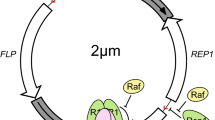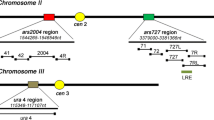Summary
Acentric yeast plasmids are mitotically unstable, apparently because they cannot freely diffuse after replicating and therefore are not included in the daughter nucleus. This behavior could result if plasmids remain attached to structural elements of the nucleus after replicating. Since DNA replication is believed to take place on the nuclear matrix, we tested whether there was a correlation between the mitotic stability of a given plasmid and the extent to which it was found associated with residual nuclear structures. Residual nuclei were prepared from yeast nuclei by extraction with either high salt, 2 M NaCl, or low salt, 10 mM lithium diiodosalicylate (LIS). Hybridization analysis was used to estimate the fraction of plasmid molecules remaining after nuclei were extracted. We examined the extent of matrix association of three ARSI plasmids, Trpl-RI circle (1.45 kb), YRp7 (5.7 kb) and pXBAT (45.1 kb) with mitotic loss rates ranging from 3–25%. In addition we examined the matrix binding of the endogenous 2 μm plasmid and the 2 μm-derived YEp 13 which is relatively stable in the presence of 2 μm and less stable in cir° strains. Among the ARS1 plasmids we observed a negative correlation between stability and matrix association, consistent with models in which binding to the nuclear matrix prevents passive segregation of ARS1 plasmid molecules. No such correlation was observed among the 2 μn plasmids. Among all plasmids examined there is a positive correlation between size and matrix association.
Similar content being viewed by others
References
Bolivar F, Rodriguez RL, Greene PJ, Betlach MC, Heynacker HL, Boyer HW, Crossa JH, Falkow S (1977) Gene 2:95–113
Broach JR, Hicks JB (1980) Cell 21:501–508
Broach JR, Strathern J, Hicks J (1979) Gene 8:121–133
Byers B, Goetsch L (1976) J Cell Biol 69:717–721
Clarke L, Carbon J (1980) Nature 287:504–509
Cockerill PN, Garrard WT (1986) Cell 44:273–282
Dani GM, Zakian VA (1983) Proc Natl Acad Sci USA 80:3406–3410
Davis RW, Thomas M, Cameron J, St John T, Scherer S, Padgett RA (1980) Methods Enzymol 65:404–411
Fangman WL, Hice RH, Chlebowicz-Sledziewska E (1983) Cell 32:831–838
Futcher AB, Cox BS (1983) J Bacteriol 154:612–622
Gordon CN (1977) J Cell Sci 24:81–93
Hsiao C-L, Carbon J (1979) Proc Natl Acad Sci USA 76:3829–3833
Hunt BF, Vogelstein B (1980) Nucleic Acids Res 9:349–363
Ito H, Fukuda Y, Murata K, Kimura A (1983) J Bacteriol 153:163–168
Jayaram M, Li Y-Y, Broach JR (1983) Cell 34:95–104
Jayaram M, Sutton A, Broach JR (1985) Mol Cell Biol 5:2466–2475
Kikuchi Y (1983) Cell 35:487–493
Livingston DM, Hahne S (1979) Proc Natl Acad Sci USA 76:3727–3731
McCready SJ, Godwin J, Mason DW, Brazell IA, Cook PR (1980) J Cell Sci 46:365–386
Messing J, Vieira J (1982) Gene 19:269–276
Mirkovitch J, Mirault ME, Laemmli UK (1984) Cell 39:223–232
Murray AW, Szostak JW (1983) Cell 34:961–970
Nelson RG, Fangman WL (1979) Proc Natl Acad Sci USA 76:6515–6519
Pansenko SM, Cameron JR, Davis RW, Lehman IR (1977) Science 196:188–189
Pardoll DM, Vogelstein B, Coffey DS (1980) Cell 19:527–536
Potashkin JA, Huberman JA (1986) Exp Cell Res 165:29–40
Potashkin JA, Zeigel RF, Huberman JA (1984) Exp Cell Res 153:374–388
Robinow CF, Marak J (1966) J Cell Biol 29:129–151
Roth GE, Blanton HM, Hager L, Zakian VA (1983) Mol Cell Biol 3:1898–1908
Seligy VL, Thomas DL, Miki BLA (1980) Nucleic Acids Res 8:3371–3391
Stinchcomb DT, Mann C, Davis RW (1982) J Mol Biol 158:157–179
Struhl K, Stinchcomb DT, Scherer S, Davis RW (1979) Proc Natl Acad Sci USA 76:1035–1039
Wahl GM, Stern M, Stark GR (1979) Proc Natl Acad Sci USA 76:3683–3687
Wu L-CC, Fisher PA, Broach JR (1987) J Biol Chem 262:883–891
Yanisch-Perron C, Vieira J, Messing J (1985) Gene 33:103–109
Zakian VA, Brewer BJ, Fangman WL (1979) Cell 17:923–934
Zakian VA, Kupfer DM (1982) Plasmid 8:15–28
Zakian VA, Scott JR (1982) Mol Cell Biol 2:221–232
Author information
Authors and Affiliations
Rights and permissions
About this article
Cite this article
Conrad, M.N., Zakian, V.A. Plasmid associations with residual nuclear structures in Saccharomyces cerevisiae . Curr Genet 13, 291–297 (1988). https://doi.org/10.1007/BF00424422
Received:
Revised:
Issue Date:
DOI: https://doi.org/10.1007/BF00424422




